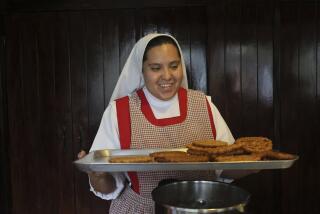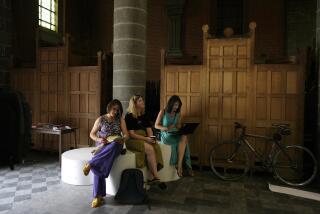Sisterly solidarity, medieval style
In a frame on my desk is a small rectangle of lace patterned with flowers and swans in fine white filigree. It is a cherished souvenir, made by one of the Benedictine sisters who live in a walled enclave, or begijnhof, by a canal on the edge of Bruges in northwestern Belgium. There they welcome visitors and quietly preserve the memory of the Beguines, a society of religious women that grew up in the Middle Ages.
The Beguines were like nuns: They worked and prayed, lived apart from men, wore habits, ministered to the bereaved, poor and sick. But they differed from them because they did not take religious vows. They freely chose to enter the society and could leave it whenever they wished (though few did). At a time of war and plague, when women were all but powerless, the Beguines achieved a rare degree of independence by following their motto: “Work hard, say little.”
Like the celibate Shakers in America, the Beguines have largely died out. In 1927, Benedictines moved into the empty begijnhof at Bruges. There and in about a dozen other towns in Belgium and northern France -- the French term for the begijnhof is beguinage -- visitors can tour the Beguines’ peaceful havens and speculate about the nature of the women who created them.
The begijnhof at Bruges is as well-preserved as the rest of the city, with its lofty Gothic churches, wide market square, richly decorated guildhalls and meandering canals. Georges Rodenbach, the late 19th century Belgian novelist and poet credited with rediscovering the forgotten medieval town, wrote of its last Beguines: “There are always those very few old, shriveled, obstinate leaves that hang on to the poplars on the sides of the roads pretending it is not November.”
To cross the triple-arched bridge over the canal that leads into the Bruges begijnhof is to briefly feel as if there are no Novembers -- especially if you happen to visit in spring, as I did, when daffodils dapple the enclosed common. Around the little greensward are a church and an infirmary and prim, whitewashed houses with stepped gables where the lay sisters lived. Some were heiresses who had not married, or didn’t want to, so they built their own residences in the begijnhof. Others were poor women, living in communal houses, ruled by a mistress.
They could move freely between town and cloister, doing charity work and business, though the gates to their miniature world were -- and still are -- locked at night. Their ambiguous social status made local people wary. Intent on practicing religion in their own way, often by forging a mystical connection with Christ, they alienated the Catholic clergy. Their prosperity, built on industrious cloth-making and tax benefits granted by patrons, earned them the envy of local tradesmen.
That prosperity is reflected in the little museum next to the front gate, where I bought my lace souvenir and paused in the black and white tiled foyer, listening to a 17th century clock strike the hour. The walls display examples of the Beguines’ handiwork and pictures of them in their graceful black habits. In the restored kitchen, the sink is lined by gleaming Delft tiles depicting scenes from the Bible.
The movement flowered in the early 1200s and reached its height in the 15th and 16th centuries, when the Beguines had enclaves throughout Western Europe, with a particularly high concentration in the Low Countries. Brussels had a thriving enclave north of the Grand Place, though little more of it has survived than the Baroque facade of the Beguines’ church, St. Jean Baptiste.
In the town of Diest, a 60-minute drive northeast of Brussels, is another begijnhof worth seeking out, this one lovingly preserved by residents who run the enclave’s tourist office, galleries and cafes. Its ornate Baroque gate symbolically separates the outside world from the quiet inner sanctum, where men, including the priest who lived at the threshold, and sometimes even male animals were not allowed.
A few Beguines at Diest lived in secluded apartments appended to the church, where food was left for them, and they listened to Mass at a window overlooking the altar.
Most of the Beguines at Diest worshipped inside St. Catherine’s Church, a simple red brick building dating from the 14th century. They sat at individual prie-dieus, separated from the congregation by an elaborate wooden choir screen. The pulpit that flanks it is a Baroque masterpiece, supported by the figures of four female saints especially revered by the society: Begga, Catherine, Agnes and Mary Magdalene.
At Diest, it is easy to imagine the Beguines, hurrying along the cobblestone streets, sweeping their front stoops, tending their gardens, saying their rosaries. Refugees and rebels, mystics and lace-makers, they found a way to live that fulfilled and set them free. Small wonder, then, that for hundreds of centuries they clung to it like obstinate autumn leaves.
*
Susan Spano also writes “Postcards From Paris,” which can be read at latimes.com/susanspano.
*
(BEGIN TEXT OF INFOBOX)
Peaceful havens
Gasthof 1618, Kerkstraat 18, B-2390 Diest, Belgium, 011-32-13-33-32-40, is a restaurant and B&B; in the begijnhof; double about $77 the first night, $58 for succeeding nights, with breakfast.
Bruges’ Beguine enclave, 011-32-50-33-00-11, has a retreat house where guests are welcome for stays of several nights; about $45 per person, including three meals. Written application required, by mail or fax, 011-32-50-33-18-81, Zusters Benedictinessen, Monasterium de Wijngaard, Begijnhof 30, B-8000 Bruges, Belgium.
More to Read
Sign up for The Wild
We’ll help you find the best places to hike, bike and run, as well as the perfect silent spots for meditation and yoga.
You may occasionally receive promotional content from the Los Angeles Times.






